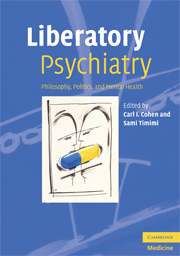Book contents
- Frontmatter
- Contents
- Contributors
- Acknowledgments
- Introduction
- 1 Working towards a liberatory psychiatry? Radicalizing the science of human psychology and behavior
- 2 Power, freedom, and mental health: a postpsychiatry perspective
- 3 Challenging risk: a critique of defensive practice
- 4 Democracy in psychiatry: or why psychiatry needs a new constitution
- 5 German critical psychology as emancipatory psychology
- 6 Psychopolitical validity in the helping professions: applications to research, interventions, case conceptualization, and therapy
- 7 Class exploitation and psychiatric disorders: from status syndrome to capitalist syndrome
- 8 Ecological, individual, ecological? Moving public health psychiatry into a new era
- 9 Children's mental health and the global market: an ecological analysis
- 10 Postcolonial psychiatry: the Empire strikes back? Or, the untapped promise of multiculturalism
- 11 A new psychiatry for a new world: postcolonialism, postmodernism, and the integration of premodern thought into psychiatry
- 12 Neoliberalism and biopsychiatry: a marriage of convenience
- 13 Psychoanalysis and social change: the Latin American experience
- 14 A new psychiatry?
- Index
- References
3 - Challenging risk: a critique of defensive practice
Published online by Cambridge University Press: 25 August 2009
- Frontmatter
- Contents
- Contributors
- Acknowledgments
- Introduction
- 1 Working towards a liberatory psychiatry? Radicalizing the science of human psychology and behavior
- 2 Power, freedom, and mental health: a postpsychiatry perspective
- 3 Challenging risk: a critique of defensive practice
- 4 Democracy in psychiatry: or why psychiatry needs a new constitution
- 5 German critical psychology as emancipatory psychology
- 6 Psychopolitical validity in the helping professions: applications to research, interventions, case conceptualization, and therapy
- 7 Class exploitation and psychiatric disorders: from status syndrome to capitalist syndrome
- 8 Ecological, individual, ecological? Moving public health psychiatry into a new era
- 9 Children's mental health and the global market: an ecological analysis
- 10 Postcolonial psychiatry: the Empire strikes back? Or, the untapped promise of multiculturalism
- 11 A new psychiatry for a new world: postcolonialism, postmodernism, and the integration of premodern thought into psychiatry
- 12 Neoliberalism and biopsychiatry: a marriage of convenience
- 13 Psychoanalysis and social change: the Latin American experience
- 14 A new psychiatry?
- Index
- References
Summary
Perhaps one of the most obvious manifestations of liberatory psychiatry was the Congress on the Dialectics of Liberation held in London at the Roundhouse in Chalk Farm in July 1967. David Cooper (1968) designated the four organizers of the Congress as anti-psychiatrists. Besides himself, these were R. D. Laing, Joseph Berke, and Leon Redler. Both Laing and Cooper gave papers at the conference, as did celebrated social theorists such as Herbert Marcuse and political activists such as Stokely Carmichael.
To Free a Generation was the alternative title of the book of the conference The Dialectics of Liberation (Cooper, 1968). This description makes clear that the book was concerned with how liberation may be achieved. The strands of anti-psychiatry were interwoven with the 1960s counterculture, whose aim was to free the spirit of the age from the nightmare of the world (Nuttall, 1970). The writings of R. D. Laing, perhaps especially The Politics of Experience and The Bird of Paradise, helped to articulate this perspective. Laing (1967) was explicit that civilization represses transcendence and so-called “normality” too often abdicates our true potentialities.
Psychedelic drugs seemed to expand the limits of imminent experience (Wolfe, 1989). One of the originators of hippie culture, Ken Kesey who, with his Merry Pranksters drove across America in a brightly painted bus, wrote One Flew Over the Cuckoo's Nest (Kesey, 1963). This successful novel depicts Randle McMurphy's attempt, possibly on behalf of the counterculture, to overthrow the bureaucratic control of Nurse Ratched in the psychiatric institution.
- Type
- Chapter
- Information
- Liberatory PsychiatryPhilosophy, Politics and Mental Health, pp. 55 - 72Publisher: Cambridge University PressPrint publication year: 2008

